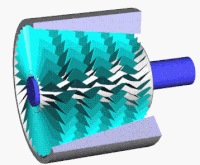
Photo from wikipedia
In this study, stall development on a previously tested axial compressor stage called NASA stage 35 was investigated by computational fluid dynamics software for the purpose of overcoming computational difficulties… Click to show full abstract
In this study, stall development on a previously tested axial compressor stage called NASA stage 35 was investigated by computational fluid dynamics software for the purpose of overcoming computational difficulties resulting from the secondary flow and tip vortex, and the results were compared to experimental data and other relevant studies in the literature. In the computational model, the k-epsilon turbulence model and the high-resolution scheme were employed to cope with flow uncertainties and to spatial discretization of the nonlinear equations, respectively. The pressure and temperature distributions obtained from k-epsilon turbulence model were in good agreement with experimental results. However, the performance map of the compressor showed that the error values between predicted total pressure ratios and experimental results increased as the compressor reached stall due to shockwave unsteadiness.
Journal Title: BioNanoScience
Year Published: 2019
Link to full text (if available)
Share on Social Media: Sign Up to like & get
recommendations!